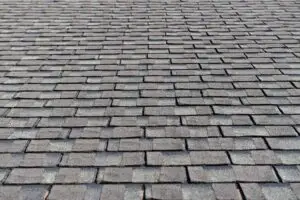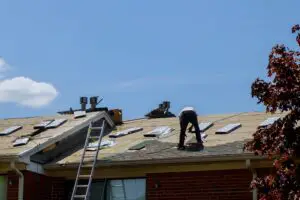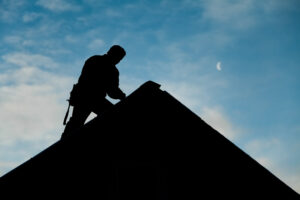Sagging Roof? What You Need To Know.
A roof is one of the most important assets of your home. You invest a lot of time, money, and energy to keep your roof in the best shape possible. However, as time goes by and it experiences stress and pressure caused mainly by the weather, a roof may suffer damages such as blisters, cracks, and sagging. I went through this last year and it wasn’t a fun experience. I want to help you be prepared and know what to do if this happens to you too.
A sagging roof is a serious concern that needs to be addressed as soon as possible. Although in some cases, it’s no need for immediate alarm, there are important things you should be aware of. We will go over several things in this article including warning signs and roof care.
To start let’s list the 9 important facts you need to know about a sagging roof.
- If the sagging is more than 1 inch, you will probably need to replace some shingles.
- You may need a new roof if the sag has been going on for a while.
- A low spot in your roof is very likely caused by ice damming from a lack of proper insulation and ventilation around the upper edge of the roof.
- If your roof is sagging, you may need a new ridge vent or chimney cap to prevent water from entering the house.
- A roof is considered saggy when there’s a 2-inch gap between shingles and you can see daylight through that gap.
- You can use a level to determine whether your roof is sagging.
- Sagging roofs are often caused by weak or rotten roof trusses.
- The best way to prevent a roof from sagging is by properly maintaining it and repairing any damages as soon as they occur.
- Finally, if you have a sagging roof, you should call a professional to repair it.
Catching Sagging Early
Let’s talk more about the first fact I shared. When you notice a sagging roof, it’s best to catch the problem early before it gets worse. If the sagging is under 1 inch, it may not need immediate attention. If the sag has been going on for a while or if it’s more than 1 inch, you will probably need to replace some shingles. Catching the issue early means you can likely do some simple repairs yourself. So remember to regularly check your roof and be on the lookout for anything unusual.
You can also have professionals check your roof from time to time just to make sure nothing is wrong. It’s always better to prevent a problem than deal with it once it happens.
When To Replace Your Roof
I know this isn’t something any homeowner wants to hear. However, it is a reality that a roof will eventually need to be replaced. Replacing your entire roof can also be necessary after a while when the damage becomes too great or widespread. This could happen if the sagging has been happening for a while or if there are other major problems with the roof.
If you do need to replace your roof, it’s best to do it in the spring or fall when the weather is milder. This will help make the process easier and less stressful for you. It’s also important to choose a good contractor who will make the process as smooth as possible.
It’s time to replace your roof if one or more of the following is happening:
- You can see daylight shining through the roof.
- The roof is sagging 2 inches or more.
- There are major cracks in the roof.
- The shingles are curling, buckling, or blistering.
- Your roof is over 20 years old.
- There’s water damage inside your home.
- The roof is leaking.
How Weather Can Cause Sagging
As I mentioned in fact three, sagging in a roof can be caused by a lack of insulation and ventilation around the upper edge of the roof. This is often due to extreme weather conditions such as very hot weather or cold weather.
If your home isn’t properly insulated, you may experience ice damming. This happens when snow on the roof melts and then refreezes along the eaves and gables of the house. This can cause roof buckling, cracks, and sagging.
The best way to prevent ice damming is by adding insulation to the upper edge of your roof. It’s also important to install proper ventilation so water can escape easily. You don’t want water to get trapped near the top of your home. This could lead to roof damage and even water damage inside your home.
Ridge Vents And Chimney Caps
If you have no idea what these two things are, it’s okay, most people don’t. However, if you find yourself facing problems with your roof then you will need to know about them.
- A ridge vent is a type of ventilation that’s installed at the peak or ridge of the roof. It’s used to allow hot air and moisture to escape from the attic. If your roof is sagging, it may be that your ridge vent isn’t working properly and needs replacing.
- A chimney cap is a cover that’s placed on top of the chimney to keep rain and snow from getting into the chimney. It also helps protect the chimney from the wind. If this gets damaged, then water and debris could get into your chimney and start damaging the roof.
Typically these repairs will need to be done by a professional.
What Is Considered Sagging?
Before you start feverishly checking your roof and being concerned, know what you’re looking for. A concerning sag in a roof is when it measures 1 inch or more. If you notice a 2-inch gap between the roof and the ceiling then this is a major sagging. You can check for this by measuring from the skylight or a nearby window to the ceiling. Use a level to measure the distance.
If you are unsure if you have normal wear or a problem, you can call a roofing company. They may charge you for a quick inspection and professional advice, but they will most likely charge less than if they had to come out and fix the problem.
Causes Of Roof Sag That’s Not Weather Related
If you live in a mild climate, you may wonder why your roof is sagging. There are other reasons for this besides the weather. Here are a few:
- Issues With Roof Trusses
If your roof was built before 1960 then it likely has trusses. These are the large wooden beams that support the weight of the house’s rooms and roofing. Issues with these can cause sagging, cracks, and other problems.
- Loose Or Broken Fasteners
If the nails or screws that hold your roof together come loose over time, then you’ll start to see problems. This is because the roof will start to move and sag in different places.
- Age Of Your Roof
The older your roof gets, the more likely it is to start sagging. This is because the materials that were used to build it may not be as strong as they once were.
Proper Roof Maintenance and Prevention Of Sagging
Of course, the best way to deal with a sagging roof is to prevent it from happening in the first place. Good roof maintenance will go a long way. Most of the time it’s nothing hard to do. You can ensure proper care and prevention of problems with the following tips!
- Inspect Your Roof Regularly: This is something you should be doing at least twice a year. By inspecting your roof regularly, you’ll be able to catch any small problems and fix them before they turn into bigger ones.
- Clean The Gutters: If you don’t clean your gutters regularly, they will fill up with debris and water will start backing up. This will cause the roofing materials to deteriorate and could lead to sagging.
- Replace Damaged Shingles Promptly: If you have any shingles that are broken, damaged, or missing, replace them right away. This is because if they’re left alone, the water will start seeping in and cause more damage.
- Trim Trees And Bushes Away From The Roof: If you don’t trim the trees and bushes around your house, they will eventually start to grow and touch the roof. This will put a lot of extra weight on the roof and could lead to sagging.
- Keep The Attic Insulated: If you have an attic, make sure it’s properly insulated. If it’s not, then the heat from your home will rise and cause the roofing materials to expand. This can also lead to sagging.
- Replace Old Roofing Materials: If you have materials on your roof that are more than 20 years old, it’s time to replace them. This is because the older materials aren’t as strong as new ones and are more likely to sag.
Does A Roof Sag Affect The Entire Roof?
While most of the roof may sag, it’s not uncommon for one section to be more affected than the others. This is usually due to a weak spot in the roofing material or improper roof installation. If you only see a small area of the roof that’s sagging, then it’s likely not a major problem and can be fixed with minimal repairs.
Just because you notice sagging, it doesn’t always mean you will have to replace your entire roof. If it’s only a small section and the roofing material is in good condition, then you may only need to replace the shingles in that area. It all depends on the cause of the sag and the severity of it.
Is Repairing Roof Sagging Expensive?
Repairing a roof that’s sagging can be expensive, but it depends on the severity of the problem. If it’s only a small area that needs to be fixed, then the repairs will be less expensive than if the entire roof needs to be replaced.
It’s important to get an estimate from a professional before you decide whether or not the roof needs to be fixed. They are the only ones who can truly determine if it’s safe to fix, or if you need a new roof.
If you do decide to replace your roof, make sure you hire a licensed contractor with insurance. It will protect both of you in case anything goes wrong during the installation process.
I hope these 9 facts about sagging roofs will help you if you find yourself in this situation. I know it can be stressful but now you are more informed on this topic and can feel more confident addressing it! Again, always consult a professional before attempting to fix roof issues. Be safe and good luck!



